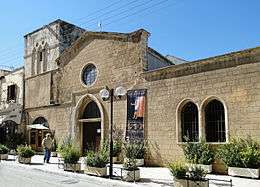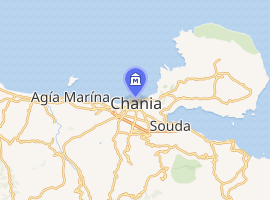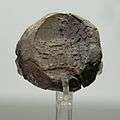Archaeological Museum of Chania
The Archaeological Museum of Chania (Greek: Αρχαιολογικό Μουσείο Χανίων) is a museum located in the former Venetian Monastery of Saint Francis at 28 Chalidon Street, Chania, Crete, Greece. It was established in 1962.
 | |

| |
| Established | 1962 |
|---|---|
| Location | 28 Chalidon Street, Chania, Crete , Greece |
| Type | Archaeological museum |
Building
The exact date that the building was constructed is unknown although it was mentioned in writing as standing during the great earthquake of 1595 and being the largest in the city.[1] It served as a Venetian church inhabited by Franciscan friars, and became an important monument of the city.[1]
During the period of the Ottoman occupation, the building was used as a mosque and named after Yussuf Pasha, the conqueror of Chania.[1] At the turn of the 20th century it became the “Idaion Andron” Cinema and after World War II it served as a storehouse for military equipment, until it was converted into the museum in 1962.[1][2] The archaeological collection of Chania itself was formerly housed in various public buildings such as the Residency, the Boys’ High School, and the Hassan Mosque.[1]
In May 2008, the Crete Gazette announced that a new museum building is due to be constructed in the Chatzidakis Camp in the historical Chalepa area of Chania overlooking the sea.[3] The modern building, designed by Theofanis Bobotis, who also designed the Patras Museum, will cover 6,500 square meters, including 1,800 square meters for exhibition halls, 140 square meters for the gallery and a 140-seat amphitheatre.[3] The new archaeological museum of Chania will also include interior and open-air exhibition areas, skywalks, a shop, a cafeteria and other visiting rooms.[3]
 Portrait bust of a Roman man
Portrait bust of a Roman man Roman emperor Hadrian
Roman emperor Hadrian
 Late Minoan sarcophagus, 1400-1200 BC.
Late Minoan sarcophagus, 1400-1200 BC.
Interior
_1.jpg)
The museum contains a substantial collection of Minoan and Roman artifacts excavated from around the city of Chania and the surrounding regional unit, including pieces from the ancient cities of Kydonia, Idramia, Aptera, Polyrinia, Kissamos, Elyros, Irtakina, Syia and Lissos, and also from Axos and Lappa in Rethymno regional unit.[4]
The museum contains a wide range of coins, jewellery, vases, sculpture, clay tablets with inscriptions, stelae and mosaics. The collection includes a clay sealing from Kasteli, with a representation of a Minoan city and its patron deity dated to the second half of the 15th century BC.[2] There is a clay pyxis with a representation of a kithara player excavated from a chamber tomb in the area of Koiliaris in Kalyves-Aptera dated to 1300–1200 BC.[2] There is also a clay tablet inscribed with Linear A script from Kasteli, dated to 1450 BC and small clay tablets with texts in Linear B script dated to 1300.[2]
The museum has a Roman floor mosaic,[4] depicting Dionysos and Ariadne. The Archaeological Museum of Chania also has an ancient Cycladic style vessel from Episkopi, Kissamos and a number of busts including one of Roman emperor Hadrian, found at the Dictynaion sanctuary in 1913 and a late Minoan sarcophagus from the necropolis of Armeni, dated to 1400–1200 BC. There is also a spherical flask, noted for its unusual ceramic type, dated to the Late Minoan III period.[4]
 Cycladic type tall cup, marble, 3200-2500 B.C.
Cycladic type tall cup, marble, 3200-2500 B.C. Cycladic type figurine, Koumasa variety, 2800-2200 B.C.
Cycladic type figurine, Koumasa variety, 2800-2200 B.C. Early Minoan bird-shaped vessel. Koumasa ware, 3000 - 2300 B.C.
Early Minoan bird-shaped vessel. Koumasa ware, 3000 - 2300 B.C. Model of an early Minoan ship. Odegetria Monastery area in Asteroussia, 1900 - 1700 B.C.
Model of an early Minoan ship. Odegetria Monastery area in Asteroussia, 1900 - 1700 B.C. Imprint of Minoan seal, Kastelli, 1450-1400 B.C.
Imprint of Minoan seal, Kastelli, 1450-1400 B.C. Neopalatial Minoan pottery
Neopalatial Minoan pottery Clay pyxis, Minoan funeral ceremony, 1300-1250 B.C.
Clay pyxis, Minoan funeral ceremony, 1300-1250 B.C. Clay oxen wheel, a toy, 800-700 B.C.
Clay oxen wheel, a toy, 800-700 B.C. Clay figurines of bird-faced women. Boeotioan workshop, 600 - 575 B.C.
Clay figurines of bird-faced women. Boeotioan workshop, 600 - 575 B.C. Ancient Greek golden diadem
Ancient Greek golden diadem Hellenistic glassware
Hellenistic glassware Statue of Artemis, Roman age
Statue of Artemis, Roman age Bust of Roman emperor Hadrianus
Bust of Roman emperor Hadrianus Ancient Roman glassware
Ancient Roman glassware Roman Age mosaic, Dionysos and satyr
Roman Age mosaic, Dionysos and satyr
References
- "Chania Archaeological Museum". Explore Crete. Retrieved August 31, 2009.
- "Archaeological Museum of Chania". Greece Museums. Archived from the original on May 6, 2009. Retrieved August 31, 2009.
- "New Archaeological Museum of Chania in Chalepa". Crete Gazette. May 2008. Retrieved August 31, 2009.
- "The Archaeological Museum of Hania". Interkriti.org. Retrieved August 31, 2009.
External links
Archaeological Museum of Chania
| Wikimedia Commons has media related to Archaeological Museum of Chania. |